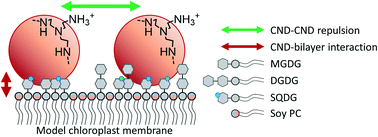Sulfolipid density dictates the extent of carbon nanodot interaction with chloroplast membranes†
Abstract
Mechanisms of nanomaterial delivery to plant chloroplasts have been explored to improve plant stress tolerance, promote photosynthesis, facilitate genetic engineering, and manufacture self-repairing biomaterials, fuels, and biopharmaceuticals. However, the molecular interactions of nanomaterials with chloroplast membranes are not well understood. In this study, we examine the interactions of an important set of chloroplast membrane lipids including sulfoquinovosyl diacylglycerols with carbon nanodots varying in functional group charge. To accomplish this objective, we constructed a novel model chloroplast membrane and interrogated the influence of carbon nanodot functional group charge, model chloroplast membrane composition, and ionic strength on the carbon nanodot-chloroplast membrane interactions using a quartz crystal microbalance with dissipation monitoring. We further examined the interaction of carbon nanodots with native chloroplasts isolated from Arabidopsis thaliana using confocal laser-scanning microscopy. Our results indicate that carbon nanodot-chloroplast membrane interactions are dictated primarily by electrostatics. Despite being the least abundant lipids in chloroplast membranes, we find that the relative abundance of sulfoquinovosyl diacylglycerol in model membranes is the component that governs both the affinity for and capacity of the membrane to interact with positively charged carbon nanodots. Rates of carbon nanodot attachment to model chloroplast membranes varied with ionic strength in a manner consistent with electrical double layer compression on carbon nanodots. Our findings elucidate chemical interactions between nanomaterials and plant biosurfaces at the molecular level and potentially contribute to establishing structure–property-interaction relationships of sustainable nanomaterials with plant organelle membranes.

- This article is part of the themed collection: Environmental Science: Nano Recent HOT Articles


 Please wait while we load your content...
Please wait while we load your content...
